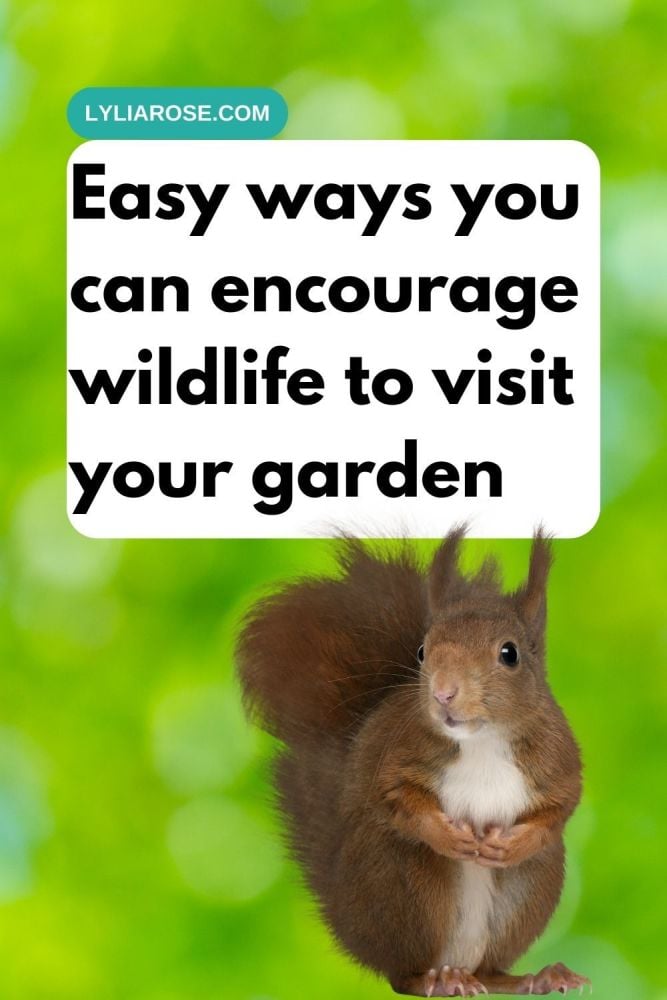How to Attract Wildlife to Your Garden: Easy, Natural Tips
Posted on
If you’re looking for simple ways to attract more wildlife to your garden, you’re not alone. Many families are now choosing to create gardens that support nature, invite birds and bees, and give children a chance to learn about the natural world. Turning your garden into a thriving space for wildlife is not only rewarding but also a beautiful way to reconnect with nature at home.

Our Garden and Why It Inspired a Wildlife-Friendly Approach
In my early twenties, when I lived in town centres and embraced a more city-centred lifestyle, I didn’t think much about wildlife. It’s not that I didn’t care—nature just wasn’t part of my everyday life. But everything changed once we settled down with children, had a garden of our own, and began to enjoy the countryside around us. That’s when we truly started thinking about creating a garden that welcomed wildlife.
We were lucky enough to have a 90-foot garden and countryside walks just five minutes away from the first suburban home we bought as a family. In fact, it was the garden that sold us on the property. I wasn’t particularly taken by the outdated décor, the stack of work that needed doing, or the tiny kitchen! But on the day we viewed it, the sunshine poured over a long, luscious green garden framed by distant hills—and we were sold.
After years of flat living with no outdoor space, it meant so much to finally have our own patch of land for the kids to play in. I’d always dreamed of growing my own vegetables, so a garden was essential when we started a family. We jumped straight into our plans—installing veg beds, adding bird feeders, and even creating a pond to encourage frogs and insects.
That first garden ignited a real love of gardening and supporting wildlife. Seven years later, when we moved to our current home, we were a little sad to leave behind the garden we had created. This new space was smaller, but we’ve somehow managed to make it even more full of life! We now have nine vegetable patches, bird feeders, bird houses, bee and butterfly homes, and a flourishing wildlife pond. It's buzzing with frogs, newts, dragonflies, damselflies, voles, mice, water snails, and multiple bird species. Every day we spot new visitors—tiny insects, fluttering butterflies, and curious birds exploring our flowerbeds and trees.
To make the space even more inviting, we’ve also started looking at adding some charming touches like Ascalon garden furniture, which blends beautifully with a wildlife-friendly garden and gives us a lovely spot to sit and watch the birds.
If you’re inspired to do the same, there are lots of easy wildlife garden ideas that can help you turn any space—big or small—into a safe and attractive haven for nature. Whether you’re planning a full garden redesign or just adding a few simple features, the suggestions below will help you get started.
How to Make Your Garden More Wildlife Friendly
Creating a wildlife-friendly garden doesn’t require a huge budget or a massive plot of land. Even the smallest green spaces can become a haven for birds, bees, and other animals with a few thoughtful changes.
1. Offer Food and Water for Birds
Providing food and clean water is one of the easiest ways to attract birds to your garden.
-
Add a variety of seeds and nuts to feeders
-
Place a shallow dish of fresh water or install a bird bath
-
Clean feeders regularly to avoid disease
Birds will soon learn where to return and may even become daily visitors.

A photo of a house cricket visiting our garden!
2. Put Up Nesting Boxes and Bird Houses
Secure nesting boxes to trees, fences or walls to offer safe nesting sites.
Choose boxes suitable for different species like robins, blue tits or sparrows. Position them out of reach of predators and away from prevailing winds. Avoid disturbing them during nesting season and clean out old nests after breeding has ended.
3. Build a Bug Hotel
Bug hotels (or insect hotels) provide shelter for beneficial insects like ladybirds, solitary bees, and beetles. You can buy one or make your own using recycled materials.
-
Use bamboo canes, wooden pallets and pinecones
-
Layer them to create cosy hiding spots
-
Place in a dry, shady area near plants
This is a fun project for children and a great way to encourage biodiversity in your garden.

A photo I took of a frog in our garden pond!
4. Grow Wildflowers for Bees and Butterflies
Wildflowers are excellent for attracting pollinators, and they add a pop of colour too. Even a small wildflower patch can make a difference.
Opt for native species like cornflowers, poppies, and oxeye daisies. If space is limited, plant wildflowers in pots or containers. Avoid using chemical weed killers and pesticides, which can harm pollinators.
Search for seed mixes such as “bee-friendly flower seeds for UK gardens” or “wildflower mix for pollinators” to find suitable options online to encourage wildlife into your garden.
5. Install a Small Wildlife Pond
Adding a pond, even a small one made from a washing-up bowl, can encourage frogs, toads, newts, and dragonflies to visit.
-
Avoid adding fish, which eat larvae and tadpoles
-
Include rocks or ramps for easy exit points - hedgehogs can fall in ponds and drown if they can't get out, so make sure there's a way out
-
Use rainwater instead of tap water when possible
Position your pond in a sunny but sheltered spot. Over time, natural plants and visitors will make it a thriving ecosystem.

Here's our second garden pond when we first installed it a few years back - it looks a bit different today!
6. Start a Compost Heap
Composting not only reduces kitchen and garden waste but also attracts worms, beetles and other decomposers that are great for your soil.
You can use a compost bin or make a pile in a corner of your garden. Add a mix of green (vegetable scraps, grass cuttings) and brown (leaves, cardboard) materials. Avoid meat, dairy and cooked food. Turn it regularly to help it break down.
This is a great way to create organic matter for flowerbeds and veg patches.

Here's a photo I took of a black winged damselfly that loves to visit our garden (and house!) because of our pond.
7. Choose Native Plants and Shrubs
Native species offer the best food and shelter for British wildlife. Plant a mix of shrubs, hedges, and trees like:
-
Hawthorn
-
Hazel
-
Dog rose
-
Blackthorn
These provide berries for birds, flowers for bees, and dense cover for nesting.
If you’re rewilding part of your garden or creating a wildlife hedge, search online for terms like “native hedgerow plants for small UK gardens” or “low-maintenance wildlife hedges UK”.
8. Let a Corner Go Wild
Leave part of your garden to grow naturally. Let the grass grow tall and wild plants take over.
You might be surprised how quickly butterflies, bees and small mammals start to appear. Avoid mowing too frequently and resist the urge to tidy it too often. Consider this your “mini meadow”.
This is one of the easiest wildlife garden ideas that requires little effort and no cost.

We use a hot compost bin which doesn't take up too much space and we have it surrounded by trees and plants!
9. Create Log and Stone Piles
Piles of logs, stones or sticks offer shelter for insects, frogs and even hedgehogs. Place them in shaded areas and avoid disturbing them.
This simple feature is especially helpful during colder months when wildlife needs somewhere safe to hibernate.

As you can see here, the kids are looking at the pond which has changed quite a bit in just 2-3 years since we installed it. Look how huge the banana tree is now! And there's my husband taking photos of some wildlife in the garden!
10. Avoid Harmful Chemicals
Pesticides, herbicides, and artificial fertilisers can harm both pests and beneficial creatures. Choose natural pest control solutions such as:
-
Companion planting
-
Garlic spray
- Neem oil spray
Also, try to source organic composts and mulches where possible.
11. Add Climbing Plants and Ivy
Vertical planting can create nesting spots and cover for small birds. Ivy in particular is a brilliant choice for wildlife:
-
Offers food and shelter
-
Blooms in autumn when few other flowers do
-
Supports bees, butterflies, and birds
Train ivy or clematis up fences or walls to add height and natural structure.

Check out this butterfly on a dandelion I took a photo of!
12. Light Considerately
Avoid harsh garden lighting that can disrupt natural behaviours of moths, bats, and hedgehogs. Instead, use solar-powered, low-lumen lights if needed. Switch them off when not in use.
If security lighting is required, opt for motion sensors rather than all-night beams.
Final Word
Making your garden a wildlife haven is easier than you might think. With just a few changes, you can attract more birds, insects, and small mammals to your outdoor space while also making it more enjoyable for your family.
Even in a small urban garden, a mix of wildflowers, feeders, and natural features can create a safe, beautiful space for wildlife. And the rewards—watching butterflies flutter by, hearing birds sing, or spotting frogs in the pond—are truly priceless.

